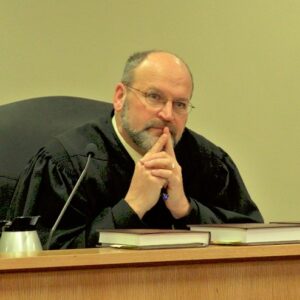Rockingham Superior Court Judge David Ruoff sent shockwaves through state government with his single-handed — critics would say arbitrary — declaration last year that the state must pay a per-pupil minimum state adequacy grant of $7,356.
The net cost to state taxpayers would be nearly $538 million per year. But despite the vast impact of his ruling, Ruoff shows no signs he’s backing down. On Tuesday, he rejected the state’s request for reconsideration in the original Conval case and in the related Rand case.
“Consistent with and subject to the clarifications outlined above, the State’s motion for partial reconsideration of the rulings set forth in the Base Adequacy Aid Order is DENIED,” (emphasis original) Ruoff wrote. “The State’s motion to stay or defer the relief granted within the Base Adequacy Aid Order is also DENIED. As explained above, pending resolution of any appeal or further legislative action, the Court DIRECTS the State to make base adequacy aid payments in an amount equal to the $7,356.01 conservative threshold established in the Base Adequacy Aid Order.”
The case is now all but certain to go before the state Supreme Court.
“We are currently in the process of reviewing the judge’s decisions and will respond as appropriate,” New Hampshire Attorney General John Formella’s spokesman told NHJournal. “We do plan to file appeals in both cases.”
Republicans like Gov. Chris Sununu have expressed their concerns about Ruoff’s ruling in the past.
“New Hampshire currently spends among the most per capita on public education than nearly any other state,” Sununu said when the original ruling came down, calling it “deeply concerning and an overreach into a decades-long precedent appropriately placed in the hands of our elected representatives in Concord.”
But advocates of shifting education funding away from local communities and onto taxpayers at the state level praised Tuesday’s decision.
“It’s good to see the court stand by its previous ruling defending the rights of students to an adequately funded education,” said Zack Sheehan, NH School Funding Fairness Project’s Executive Director.
“Increasing base adequacy doesn’t increase total education spending but instead shifts some of the responsibility for school funding back to the state, where the courts have consistently ruled it belongs, and off of overburdened local property taxpayers.”
The state argued that Ruoff was essentially legislating from the bench by determining what constitutes “adequate” base education funding rather than allowing the elected representatives of the people to determine that number through the democratic process.
Ruoff rejected that argument. “By setting a base adequacy aid funding threshold, the Court did not intend to suggest that the legislature cannot enact meaningful changes to the education funding scheme. Rather, the Court intended to ensure that if the legislature maintains the existing scheme in substantial part, the legislature will not repeat the constitutional violations of the past by funding base adequacy aid at a level the plaintiffs have already proven to be unconstitutional.”
And, Ruoff added, concerns about separation of powers are overridden by New Hampshire’s declaration that “constitutionally adequate public education is a fundamental right.”
If it’s a “fundamental” right, then it is beyond the reach of the legislature, Ruoff suggested.
In 1993 and 1997, the state Supreme Court ruled in the Claremont litigation that every child in the state has a fundamental right to an adequate education, and the duty to fund it falls on the state. Some critics of Ruoff’s ruling say the original Claremont case was wrongly decided, and the current court will undo the damage and return education funding questions to state legislators and local school boards where they belong.



